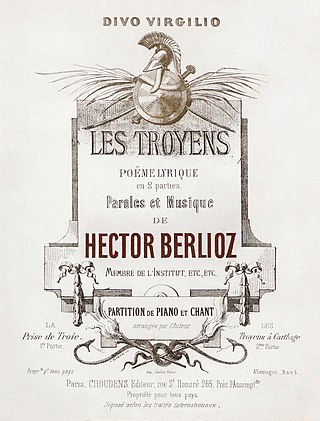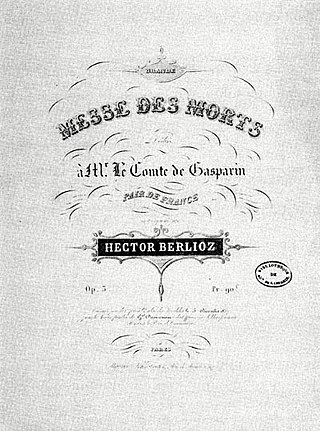
The saxhorn is a family of valved brass instruments that have conical bores and deep cup-shaped mouthpieces. The saxhorn family was developed by Adolphe Sax, who is also known for creating the saxophone family. The sound of the saxhorn has a characteristic mellow tone quality and blends well with other brass.

Louis-Hector Berlioz was a French Romantic composer and conductor. His output includes orchestral works such as the Symphonie fantastique and Harold in Italy, choral pieces including the Requiem and L'Enfance du Christ, his three operas Benvenuto Cellini, Les Troyens and Béatrice et Bénédict, and works of hybrid genres such as the "dramatic symphony" Roméo et Juliette and the "dramatic legend" La Damnation de Faust.

Symphonie fantastique: Épisode de la vie d'un artiste… en cinq parties Op. 14, is a program symphony written by the French composer Hector Berlioz in 1830. It is an important piece of the early Romantic period. The first performance was at the Paris Conservatoire on 5 December 1830. Franz Liszt made a piano transcription of the symphony in 1833.

Roméo et Juliette is a seven-movement symphonie dramatique for orchestra and three choruses, with vocal solos, by French composer Hector Berlioz. Émile Deschamps wrote its libretto with Shakespeare's play as his base. The work was completed in 1839 and first performed on 24 November of that year, but it was modified before its first publication, in 1847, and modified again for the 2ème Édition of 1857, today's reference. It bears the catalogue numbers Op. 17 and H. 79. Regarded as one of Berlioz's finest achievements, Roméo et Juliette is also among his most original in form and his most comprehensive and detailed to follow a program. The vocal forces are used in the 1st, 5th and 7th movements.

Orfeo ed Euridice is an opera composed by Christoph Willibald Gluck, based on the myth of Orpheus and set to a libretto by Ranieri de' Calzabigi. It belongs to the genre of the azione teatrale, meaning an opera on a mythological subject with choruses and dancing. The piece was first performed at the Burgtheater in Vienna on 5 October 1762, in the presence of Empress Maria Theresa. Orfeo ed Euridice is the first of Gluck's "reform" operas, in which he attempted to replace the abstruse plots and overly complex music of opera seria with a "noble simplicity" in both the music and the drama.

La damnation de Faust, Op. 24 is a work for four solo voices, full seven-part chorus, large children's chorus and orchestra by the French composer Hector Berlioz. He called it a "légende dramatique". It was first performed at the Opéra-Comique in Paris on 6 December 1846.

Benvenuto Cellini is an opera semiseria in four tableaux by Hector Berlioz, his first full-length work for the stage. Premiered at the Académie Royale de Musique on 10 September 1838, it is a setting of a libretto by Léon de Wailly and Henri Auguste Barbier, who invented most of the plot inspired by the memoirs of the Florentine sculptor Benvenuto Cellini. The opera is technically challenging and was until the 21st century rarely performed. But its overture sometimes features in orchestral concerts, as does the concert overture Le carnaval romain which Berlioz composed from material in the opera.

Les Troyens is a French grand opera in five acts, running for about five hours, by Hector Berlioz. The libretto was written by Berlioz himself from Virgil's epic poem the Aeneid; the score was composed between 1856 and 1858. Les Troyens is Berlioz's most ambitious work, the summation of his entire artistic career, but he did not live to see it performed in its entirety. Under the title Les Troyens à Carthage, the last three acts were premièred with many cuts by Léon Carvalho's company, the Théâtre Lyrique, at their theatre on the Place du Châtelet in Paris on 4 November 1863, with 21 repeat performances. The reduced versions run for about three hours. After decades of neglect, today the opera is considered by some music critics as one of the finest ever written.

Harold en Italie, symphonie avec un alto principal, as the manuscript describes it, is a four-movement orchestral work by Hector Berlioz, his Opus 16, H. 68, written in 1834. Throughout, the unusual viola part represents the titular protagonist, without casting the form as a concerto. The movements have these titles, alluding to a programme:
- Harold in the mountains
- March of the pilgrims
- Serenade of an Abruzzo mountaineer
- Orgy of bandits

The Grande Messe des morts, Op. 5, by Hector Berlioz was composed in 1837. The Grande Messe des Morts is one of Berlioz's best-known works, with a tremendous orchestration of woodwind and brass instruments, including four antiphonal offstage brass ensembles. The work derives its text from the traditional Latin Requiem Mass. It has a duration of approximately ninety minutes, although there are faster recordings of under seventy-five minutes.
The Lacrimosa, also a name that derives from Our Lady of Sorrows, a title given to The Virgin Mary, is part of the Dies Irae sequence in the Requiem Mass. Its text comes from the Latin 18th and 19th stanzas of the sequence. Many composers, including Mozart, Berlioz, and Verdi have set the text as a discrete movement of the Requiem.
David Adam Cairns is a British journalist, non-fiction writer and musician. He is a leading authority on the life of Berlioz.

Tristia, Op. 18, is a musical work consisting of three short pieces for chorus and orchestra by the French composer Hector Berlioz. Apart from its title, it has nothing to do with the collection of Latin poems by Ovid. The individual works were composed at different times and published together in 1852. Berlioz associated them in his mind with Shakespeare's Hamlet, one of his favourite plays. They were never performed during the composer's lifetime.
"The Three Bs" generally refers to the supposed primacy of Johann Sebastian Bach, Ludwig van Beethoven, and Johannes Brahms in classical music. It was derived from an expression coined by Peter Cornelius in 1854, which added Hector Berlioz as the third B to occupy the heights already occupied by Bach and Beethoven. Later in the century, conductor Hans von Bülow substituted Brahms for Berlioz.

Les nuits d'été, Op. 7, is a song cycle by the French composer Hector Berlioz. It is a setting of six poems by Théophile Gautier. The cycle, completed in 1841, was originally for soloist and piano accompaniment. Berlioz orchestrated one of the songs in 1843, and did the same for the other five in 1856. The cycle was neglected for many years, but during the 20th century it became, and has remained, one of the composer's most popular works. The full orchestral version is more frequently performed in concert and on record than the piano original. The theme of the work is the progress of love, from youthful innocence to loss and finally renewal.

French composer Hector Berlioz wrote a number of "overtures", many of which have become popular concert works. They include true overtures, intended to introduce operas, but also independent concert overtures that are in effect the first orchestral tone poems.

The New German School is a term introduced in 1859 by Franz Brendel, editor of the Neue Zeitschrift für Musik, to describe certain trends in German music. Although the term has frequently been used in essays and books about music history of the 19th and early 20th centuries, a clear definition is complex.
La Symphonie fantastique is a 1942 French drama film by Christian-Jaque and produced by the German-controlled French film production company Continental Films. The film is based upon the life of the French composer Hector Berlioz. The title is taken from the five-movement programmatic Symphonie fantastique of 1830. The film lasts around 90 minutes and was first shown at the 'Normandie' cinema in Paris on 1 April 1942. The posters at the premiere contained the sub-title 'La Vie passionnée et glorieuse d'un génie'.

José Melchor Gomis y Colomer was a Spanish Romantic composer.
Julian Gordon Rushton is an English musicologist, born in Cambridge. He has contributed the entry on Mozart in The New Grove Dictionary of Opera and several other articles in The New Grove Dictionary of Music and Musicians and other reference works. He has written a critical study of the style of Hector Berlioz and was involved in critical editions of that composer's works. In 1999, he published an analysis of Elgar's Enigma Variations. His book Coffee with Mozart (2007) has been translated into German. He also wrote Mozart and Mozart: An Extraordinary Life (2006). In addition to his 1983 work The Musical Language of Berlioz, he wrote The Music of Berlioz as well as several articles on Mozart, Berlioz, and Elgar. He was General Editor of Cambridge Music Handbooks, contributing Berlioz, Roméo et Juliette and Elgar, 'Enigma' Variations. He has edited works by Charpentier, Berlioz, Elgar, and Vaughan Williams. He is editor the Cambridge Berlioz Encyclopedia (2018). He was for 25 years chair of the Editorial Committee of Musica Britannica.















